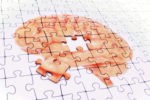Finding A Cure For ALS
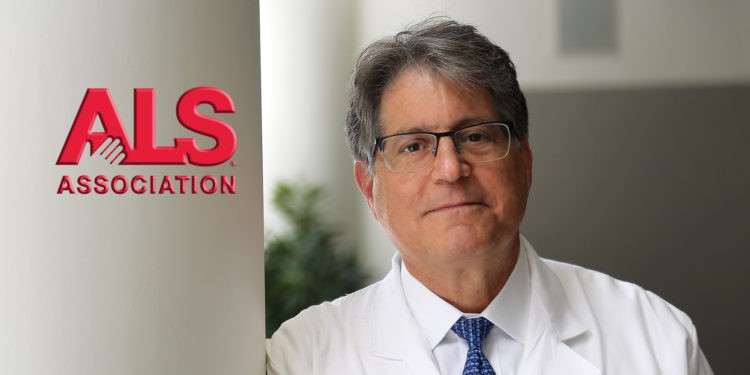
Finding A Cure For ALS
Photos by Rich Riggins for the Robert Packard Center
Commonly referred to as Lou Gehrig’s disease, after the famous baseball player who was diagnosed with the disease, ALS (amyotrophic lateral sclerosis) is a progressive neurodegenerative disease that affects nerve cells in the brain and spinal cord. While most patients may die within three to four years after diagnosis, others may pass within months while a select few may survive for a decade or even longer. Due to the complexity of the disease and because of individual patient variables, no specific time table exists to determine for how long one will survive, and even more paralyzing is the understanding that no current treatment exists to slow down or halt the disease. And as patients present myriad questions to their physicians, the answers cannot be readily or accurately conveyed, nor can any combatting drug be readily dispensed.
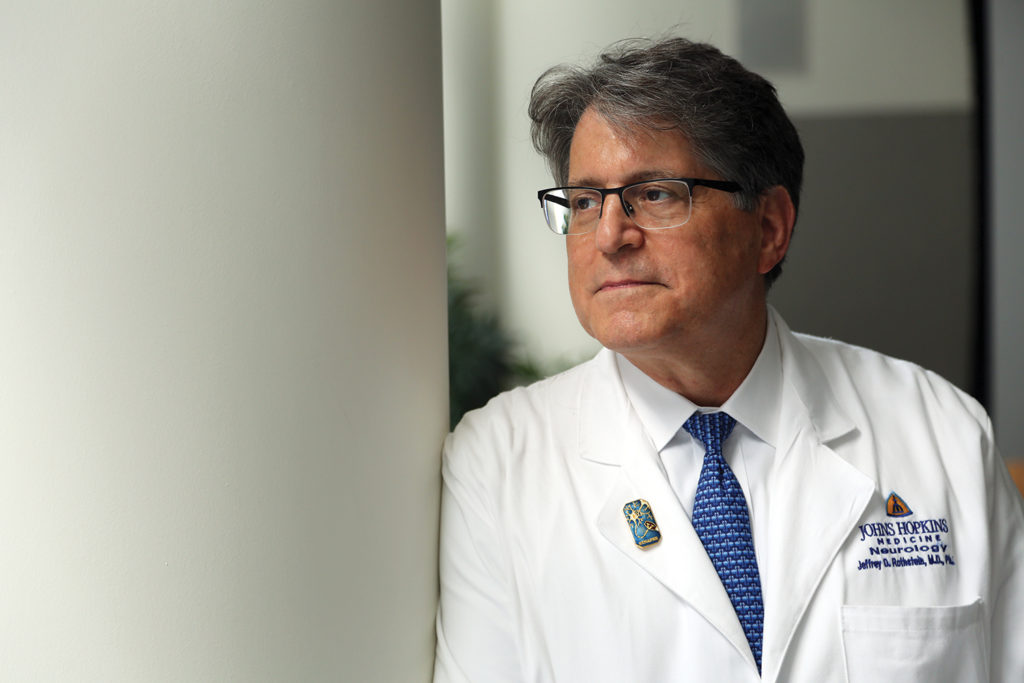
“As an ALS researcher, it’s incredible to see so many leaders in business come together for this cause!”
~ Jeffrey Rothstein, M.D., Ph.D
“We have made significant strides in understanding this disease, including its inherited form and any risk factors,” explained Jeffrey Rothstein, M.D., Ph.D, Professor of Neurology and Neuroscience, Director of the Brain Science Institute and of the Robert Packard Center for ALS Research – Johns Hopkins University School of Medicine, who continues to maintain a positive stance with respect to good news. “I like to think that a good treatment for ALS will prevail within my lifetime.”
One exciting initiative responsible for increased optimism is called Answer ALS, the brainchild of Dr. Rothstein, who describes it as “the most comprehensive project ever undertaken in ALS and perhaps the most comprehensive project ever undertaken in any type of neurologic disease.”
This nationwide program, comprised of 1,000 patients and a whole consortium of individuals, is fueled by its mission to build the most comprehensive assessment of ALS – clinical, genetic, molecular and biochemical – from a vast sampling of ALS patients in the U.S., reflecting real people living with the disease. Through the partnership of big data technology and machine learning, the information acquired will be aggressively mined to pull back the cover on ALS and potentially discover what causes this disease, its subtypes and pathways, as well as point the arrow towards drug targets.
Additionally, Answer ALS is committed to developing information that is readily available to researchers world-wide at no cost to further propel their research efforts as well, working together to find a solution in the most efficient manner possible. This organization serves as a foundation for new clinical trials and new ways to subgroup participants to better discover successful drugs and to find responsive biomarkers or diagnostics. In short, it is taking a community-based effort on the fast track towards increased insight and discovery, with hope and promise at the wheel. Together, they share ideas, successes, and even the challenges.

Dr. Rothstein also directs the Brain Science Institute, dedicated to bridging basic and clinical neuroscience including a large drug discovery group to identify novel therapeutics for neurological and psychiatric disease.
In the on-going fight against ALS, the efforts of researchers world-wide have taken flight in recent months, so to speak. In September of this year, it was announced American Airlines will begin a multi-year financial commitment of $1 million to the Answer ALS research project through the Answer ALS Foundation.
“As an ALS researcher, it’s incredible to see leaders in business come together for this cause,” commented Dr. Rothstein, “American’s commitment and leadership has raised much needed funds to continue the important work we are doing to help solve ALS. The Answer ALS research project is the largest coordinated and aggressive ALS research effort designed to quickly find answers to a disease that’s largely been a mystery. So, we are grateful committed groups like those American gathered for the tournament are also being aggressive in helping us raise those needed dollars.”*
American Airlines Vice President of Finance, Peter Warlick, is undergoing his own battle with ALS and it is his desire to help change the outcome for future ALS patients. While he realizes at this time the progress in research may not directly benefit him, he hopes that future patients will experience a more favorable outcome. He believes that Answer ALS provides the best opportunity to reach that outcome.**

For the 17th time, Packard scientists, colleagues, friends, and supporters gathered in downtown Baltimore to discuss the year’s progress in the fight against ALS.
On the local front, strides are continuing to be made at the ALS Association, Mid-America Chapter serving Kansas, Nebraska and Western Missouri. On September 16, 2017, the Walk to Defeat ALS® was held at Kauffman Stadium in Kansas City, Missouri. Nearly 4,000 walkers joined forces to raise just over a half million dollars, an integral part of this year’s total fundraising dollars for the chapter. Healthy Kansas City magazine was one of the proud sponsors.
The Walk to Defeat ALS® is the number one way to unite and raise funds for those who are living with ALS, encouraging people to walk together towards a cure for this disease. Throughout the Midwest Chapter’s region, ten walks are held annually, and a combined $1.1 million is forecasted to be raised this year alone as a result of those events.
The fundraising dollars are then distributed for care services, research, advocacy, and stewardship, the four core components of the mission of the walk. These dollars go to provide much-needed assistance for patients and their families throughout all aspects of the disease. The money used for research helps to fund over 150 laboratories around the world while advocates continue to tell ALS stories in Washington, DC so that policies can be enacted to improve the lives of those living with ALS.
Sherrie Hanneman, Director of Communications for the Mid-America chapter, has an unwavering passion for the mission this organization upholds and the people it serves.

The Robert Packard Center for ALS Research at Johns Hopkins is a science-based nonprofit whose research and administrative funding is entirely donor based.
“The money raised from this walk supports our chapter, and the lion’s share stays here in the metro area,” she noted. “The funds go to maintain our support groups, ALS clinics, loan closets, educational materials, and activities of daily living kits, which are those miscellaneous items insurance typically doesn’t cover, such as zipper pullers or long straws, the things most people don’t realize they need until they need it. We also help them with considerations in making home modifications before they even think about needing that done. We tell our clients they only need to worry about today; we will worry about tomorrow for you.”
For Hanneman and the rest of the staff, their job is to help patients manage a chronic disease, not a medical emergency.
“They have enough stress in their lives,” she paused.
Thanks to the annual walk, many individuals have come forward to ask how they can help even further, and Hanneman is thrilled the walk gives everyone an opportunity to pitch in and help on some level.
“The walk helps fund programs and services that patients and their families can have access to,” she explained.
While Hanneman gives appreciable credit to the famous Ice Bucket Challenge of 2014, which was an extraordinary campaign to raise funds for ALS research and awareness, she also understands so much more needs to be done.
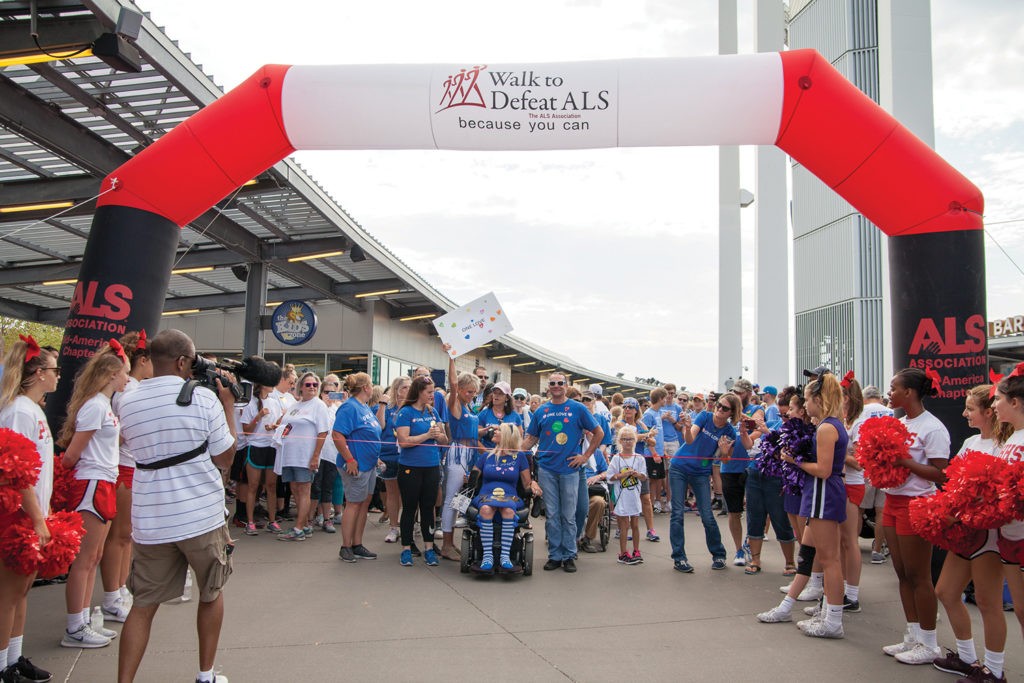
Thousands of participants Walked to Defeat ALS on September 16, 2017 at Kauffman Stadium. Their support made a difference in the fight against ALS.
“Fortunately, because of the Ice Bucket Challenge, more people now realize there’s help out there, and that awareness continues to stay on a steady rise,” she indicated, further emphasizing it is not necessarily that more people are diagnosed with the disease; it’s just that more people are aware of what is available in terms of support, education and assistance.
Even though donations dipped a bit in 2015 and 2016, this year has seen a renewed surge in giving, and Hanneman attributes much of that success to the walks.
“We do these walks because everyone can do them,” she noted. “It’s an inclusive one-mile, non-competitive stroll in which everyone can participate. We even have many individuals do the walk in wheelchairs.”
Hanneman further added that, unlike a more expensive golf tournament or evening gala (which are also a part of the local chapter’s fundraising agenda), a walk is recession-proof in that people can donate at levels with which they are comfortable. Even if it’s just one dollar, every dollar counts.
“Our walks encourage involvement available to everyone,” she said.
Hanneman sings the praises of those within the medical community who work tirelessly on finding a cure for this horrendous disease, and just because she and many others may not have the medical background to discover that cure, we can all be a part of the situation by virtue of how we become involved at our own unique level.
“Even by participating in the walk, you are a part of that overall equation. We all can do our part, no matter how small, to work towards a cure,” she smiled.
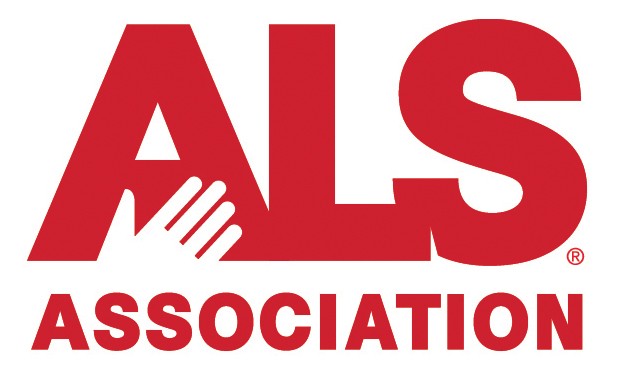
For more information on Answer ALS, go online at answerals.org. For more information on ALS Association Mid-America Chapter, go online at alsa-midamerica.org or call the Kansas City office at 913.648.2062.
Sources: globenewswire.com (Fort Worth, Texas, May 31, 2017); answerals.org*, news.aa.com**; als.net.
